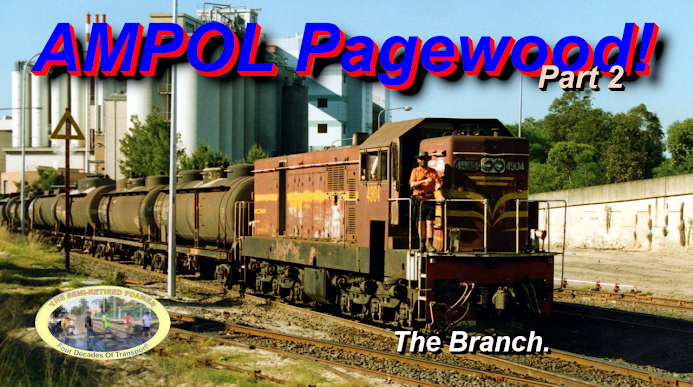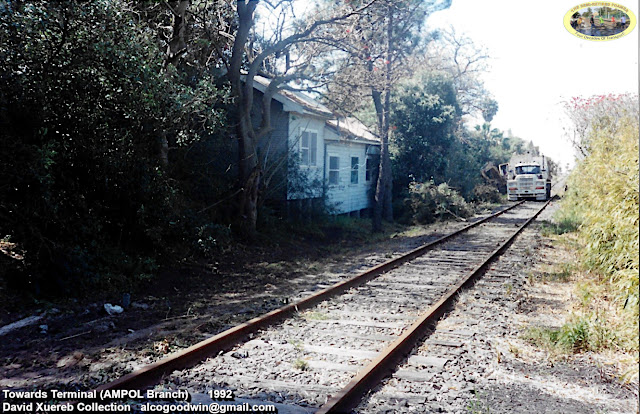Article: Brad Peadon
THE BRANCH
The AMPOL (Total) branch wasn’t very long - just 664 metres (2,178 feet) - essentially more of an extended siding. However, this modest stretch held plenty of interest for railway modellers.
The line branched off just east of today’s Page Street overbridge, with the points facing Marrickville, where it passed through a boundary gate and immediately crossed Ocean Street on a curve. This was the first of two level crossings along the line. At the time, Ocean Street was a major thoroughfare for traffic from Botany and was protected by manually operated Type F flashing lights from 1958.
These lights likely became obsolete after the Page Street Overbridge opened on December 4, 1979, reducing Ocean Street’s traffic significantly. Remarkably, the derelict remains of these lights persisted into the mid-1990s, possibly until the branch’s closure, when most signage and rail were removed.
After crossing Ocean Street, the line curved slightly more, traversing the driveway of a nearby house before entering a narrow right-of-way. The track ran between the back fences of Young Street houses on one side and industrial estates on the other. The industrial area was level with Anderson Street, which elevated the branch along much of its length. Beyond the Young Street properties lay the expansive grounds of Davis Gelatin.
By 1993/94, the closest structure to the railway formation - an office building - was derelict. Today, it has been refurbished and now operates as the Treehouse Restaurant. Although Davis Gelatin’s property spanned from Page Street to Anderson Street, no record of a formal agreement involving the railway line exists.
The branch continued northeast, passing another warehouse, crossing Baker Street, and entering the AMPOL terminal. This terminal opened in 1955 under the name ‘United Petroleum Ltd’ and underwent several name changes: to ‘Anglo United Petroleum Ltd’ in 1957, ‘Total Oil Products Australia Ltd’ in 1958, and finally, AMPOL in 1984 after purchasing Total. Despite these changes, the branch remains commonly referred to as the ‘Total branch.’
Baker Street was a quieter place back then, with simpler Type B crossing signage. Since its opening in 1958, the terminal’s yard layout underwent three transformations before its closure, with the last refurbishment occurring in 1994, only a few years before the branch ceased operations.
See below for the various track layouts.
The State of the Branch in 2025
Today, very little of the old branch remains visible. Extensive roadwork on Ocean Street has erased most traces of the track, though a small section of rail can still be found on the terminal side of the street, along with the mostly buried base of the former crossing lights. However, all evidence of the Baker Street crossing, including an aged crossing sign that long outlasted the line, has been obliterated. A shallow cutting still marks the junction, but the rest of the formation has been fenced off, landscaped, and partially developed over.
Looking at the south-east corner of the now obliterated intermediate staff hut which was situated between the junction and Page Street bridge.
Photo: David Xuereb

The intermediate staff hut again, this time being inspected by the legendary Daven Walters.
Photo: David Xuereb
Inside the intermediate staff hut showing the staff instrument.
David Xuereb Collection
Above and below.
Point rodding between the levers and junction points.
David Xuereb Collection.
Above and below.
Junction points. Ocean Street crossing just beyond that fenceline.
David Xuereb Collection.
Ok, I admit I had no idea what the thing above actually does, so I decided to ask on the Botany Railway Line SIG and got the following two responses.
John Pitcher
That would be a drawer lock style releasing device. Basically the Annette key goes in and unlocks another key (drawer key) that is used for the branch.
Ben Dihen
Don’t forget to place the staff in the drawer first otherwise you can’t get the key out.
David Xuereb Collection.
Above and below.
Point indicator at the junction of the branch.
David Xuereb Collection

Point levers for the branch which is seen diverging to the left.
Photo: David Xuereb
A recent photo of the former junction from Ocean Street.
Recent road works have obliterated most signs that this was once a railway.
Photo: Brad Peadon

Above and three below.
The Ocean Street level crossing back when the branch was still in use. The crossing lights, and the activation button on the short pole beside, were not in use.
Photo above: Brad Peadon
Three below:David Xuereb Collection
Above and below.
The Ocean Street crossing following major work to remove the remains of the crossing.
Above is looking towards the terminal, the other being towards the junction.
Photo: Brad Peadon
From Ocean Street the former right of way is seen looking in the direction of the former terminal.
Access to this section is not possible now.
Photo: Brad Peadon
The very last bit of remaining rail on the entire branch.
However, it is thought all that across Ocean Street is probably under the tar.
Photo: Brad Peadon
Curve just beyond Ocean Street, looking towards the terminal.
David Xuereb Collection
A wee bit further from the above spot.
David Xuereb Collection
An early shot of an Indian Red 73 class shunting the branch.
Photographer: Unknown.
Above and below.
Gates at the Ocean Street end of the branch.
I can't recall a time I saw these closed during my 90s visits to the line.
David Xuereb Collection
Gates at the Ocean Street end of the branch during removal and remediation work.
Photo: Brad Peadon
Above and below.
Other random branch shots showing lineside structures.
Photos: David Xuereb
The legendary Stephen Miller on a tarred path that ran from the east side of the line to a crossing made of sleepers.
There was no continuation of the path on the west side, and the purpose of it is still unknown.
Photo: David Xuereb
Above and below
Stephen J Miller exploring the branch with a Jumbo visible shunting the terminal in the distance.
Photo: David Xuereb
--------------------------------------------------------------
The following images, either taken by David Xuereb (ummarked), or are from his collection, show the section through land owned by David Gelatine.
Can't recall why the truck was there.
As the plant had closed, It may have been part of the demolishing process.
David Xuereb Collection
Buildings in the former Davis Gelatine plant before being torn down.
Photo: David Xuereb
Davis Gelatine property to the east of the branch, with the massive Kellogg's plant in the distance.
Photo: David Xuereb
Above and below
More small buildings that were part of the Davis Gelatine plant.
David Xuereb Collection above
David Xuereb below.
Above and below
Davis Gelatine water treatment plant between the railway and Anderson Street.
Photos: David Xuereb.
Pipe between the water treatment plant and main production area.
Photo: David Xuereb.
--------------------------------------------------------------
Baker Street crossing and terminal.
Factory on south-west corner of Baker Street crossing.
Photo: David Xuereb
Looking across Baker Street and into the terminal.
David Xuereb collection.
Baker Street looking back towards the junction.
Photo: Brad Peadon.
The last surviving railway remnants on Baker Street before they were also removed.
Images: Courtesy of Google Streetscape.
Former rail entrance into terminal from Baker Street.
No trace of this formation still remains.
Photo: Brad Peadon.
Aerial image from the 1937 'Davis Gelatine Review' with the tree line marking out where the railway would eventually run.
At the time there was no loading gantry.
Photo: National Library of Australia
There be more to come in Part 3.
We would like to hear from anyone who is able to contribute more photos or information on the AMPOL branch for us to include in a future update or possible part 4.
Did you work on it, work at the terminal, shunt train over it, or just take some photos?
Please email us at our alcogoodwin email address.
-------------------------------------------------------------

-----------------------------------------------------------------------
Thanks to Josh Beveridge, Bradly Coulter, Ben Dihen, Doug Erskine, John Pitcher, Roger Renton, David Xuereb, and the Botany Historical Trust (Eastgardens Library).
Smithston Design & Graphics
National Library of Australia
Google Maps/Earth
Wikipedia
The Story Of The Sydnenham To Botany Railway by Neville Pollard.
Check our new Linktree site above for piles of dreary transport entertainment. -----------------------------------------------------------------------












































































No comments:
Post a Comment